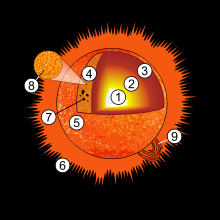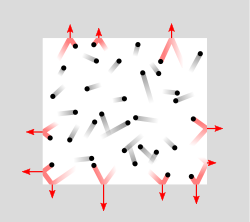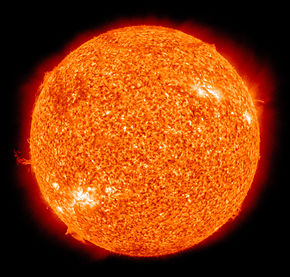When we turn on the tap, and water comes out the end of a hose, it is because water pressure is forcing it out. If we turn the tap (valve) on more (open it), more water comes out the hose because there is more pressure, but this pressure is exerted in all directions, not just out the end. The water in the hose is also putting pressure on the sides of the hose, and this is adding to the resistance of the flow of water.
There is a limit to the amount of water you can get from any diameter of pipe, because increasing the pressure only increases the pressure on the sides of the pipe. The water will actually slow or stop.
The sun has a core of iron, and it takes about 3 million years for the radiation to travel from the centre to the outside.
You can think about the sun as a giant, three dimensional or spherical pipe, where the pressure on the water (photons or radiation) at the outside stops any more radiation from escaping. The only way to increase it is by making the sun bigger.
Of course there is a little more to this, other factors are at play.

An illustration of the structure of the Sun:
1. Core
2. Radiative zone
3. Convective zone
4. Photosphere
5. Chromosphere
6. Corona
7. Sunspot
8. Granules
9. Prominence
The Sun's stellar classification, based on spectral class, is G2V, and is informally designated as a yellow dwarf, because its visible radiation is most intense in the yellow-green portion of the spectrum and although its color is white, from the surface of the Earth it may appear yellow because of atmospheric scattering of blue light.[14][15] In the spectral class label, G2 indicates its surface temperature of approximately 5778 K (5505 °C), and V indicates that the Sun, like most stars, is a main-sequence star, and thus generates its energy by nuclear fusion of hydrogen nuclei into helium. In its core, the Sun fuses 620 million metric tons of hydrogen each second. Once regarded by astronomers as a small and relatively insignificant star, the Sun is now thought to be brighter than about 85% of the stars in the Milky Way galaxy, most of which are red dwarfs.[16][17]
Pressure (the symbol: P) is the force per unit area applied in a direction perpendicular to the surface of an object. Gauge pressure is the pressure relative to the local atmospheric or ambient pressure.

Pressure as exerted by particle collisions inside a closed container.

The Sun is the star at the center of the Solar System. It is almost perfectly spherical and consists of hot plasma interwoven with magnetic fields.[10][11] It has a diameter of about 1,392,000 km, about 109 times that of Earth, and its mass (about 2×1030 kilograms, 330,000 times that of Earth) accounts for about 99.86% of the total mass of the Solar System.[12] Chemically, about three quarters of the Sun's mass consists of hydrogen, while the rest is mostly helium. The rest of it (1.69%, 5,628 times the mass of Earth) consists of heavier elements, including oxygen, carbon, neon, iron, and others.[13]
As the Sun consists of a plasma and is not solid, it rotates faster at its equator than at its poles. This behavior is known as differential rotation, and is caused by convection in the Sun and the movement of mass, due to steep temperature gradients from the core outwards. This mass carries a portion of the Sun’s counter-clockwise angular momentum, as viewed from the ecliptic north pole, thus redistributing the angular velocity. The period of this actual rotation is approximately 25.6 days at the equator and 33.5 days at the poles.
Pressure is the effect of a force applied to a surface. Pressure is the amount of force acting per unit area. The symbol of pressure is P.[1][2]
Formula
| Conjugate variables of thermodynamics |
|
|---|---|
| Pressure | Volume |
| (Stress) | (Strain) |
| Temperature | Entropy |
| Chemical potential | Particle number |
Mathematically:
where:
- P is the pressure,
- F is the normal force,
- A is the area of the surface area on contact
Pressure is a scalar quantity. It relates the vector surface element (a vector normal to the surface) with the normal force acting on it. The pressure is the scalar proportionality constant that relates the two normal vectors:
The minus sign comes from the fact that the force is considered towards the surface element, while the normal vector points outward.
It is incorrect (although rather usual) to say "the pressure is directed in such or such direction". The pressure, as a scalar, has no direction. It is the force given by the previous relationship to the quantity that has a direction, not the pressure. If we change the orientation of the surface element, the direction of the normal force changes accordingly, but the pressure remains the same.
Pressure is transmitted to solid boundaries or across arbitrary sections of fluid normal to these boundaries or sections at every point. It is a fundamental parameter in thermodynamics, and it is conjugate to volume.

Internal structures of main sequence stars, convection zones with arrowed cycles and radiative zones with red flashes. To the left a low-mass red dwarf, in the center a mid-sized yellow dwarf and at the right a massive blue-white main sequence star.

